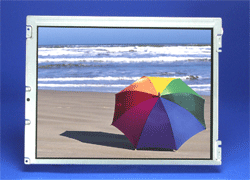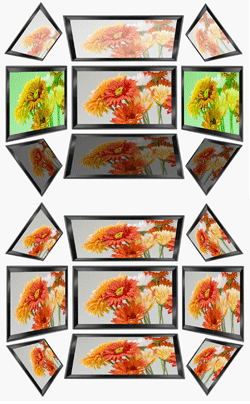Remembering that an industrial display serves a different purpose than a consumer device is the first step in device selection
BY SRI PERUVEMBA
Sharp Microelectronics of the Americas
Camas, WA
http://www.sharpsma.com
Weighing the pros and cons of the features and specifications is an essential step in any display selection process, and as industrial devices using displays have a different application than typical consumer-oriented products. The basic elements that should be considered include optical performance, electronics, durability, and mechanical considerations.
Contrast
Unlike consumer screens intended for direct viewing, with an industrial-grade display the user may not be at an optimum distance or in ideal lighting conditions. A display with higher contrast is preferable. In most industrial applications that use 10.4-, 12.1-, or 15-inch displays, a contrast ratio of 450:1 is ideal.
Color
In some industrial applications, particularly where color information is more critical than text or numbers, it is important to measure the color palette as a percentage of NTSC (National Television Standards Committee) color gamut. In LCD products, the color gamut is influenced heavily by the backlight. CCF (cold cathode fluorescent) backlights are the predominant technology and typically allow between 70% and 80% of the NTSC color gamut.
In certain applications, this range is not sufficient and there is a need to achieve closer to 100% of the NTSC color gamut. This full color gamut is typically accomplished by using LED backlights in the LCD product (see Fig. 1 ).

Fig. 1. This 23-in. display uses an RGB LED backlight for an increased color gamut.
Brightness
Given that most flat panel displays are used in indoor applications, a 15-in.-diagonal LCD that is about 250 to 300 cd/m2 (nits) bright is frequently used; however, this level of brightness isn’t adequate in an industrial environment where the ambient light is much greater and competes with the backlight of the LCD. Also, in applications where a touchscreen is employed, the touchscreens can reduce the light that is emitted from the display, making it look dimmer. In typical medical, industrial, and kiosk applications, a brightness of 450 nits is desired.
Response time
Historically, passive-display technologies, including LCDs, have had poor response times compared to emissive display technologies. In consumer displays, whether they are laptop displays or desktop monitors, a response time of less than 30 ms is considered ample; however in industrial, medical, and gaming applications, where the user can perceive the motion in a dynamic content environment, a faster response time in the LCD is desired. Newer technologies like Advanced Super View (ASV) or Multivariate Vertical Alignment (MVA) have reduced this response time to less than 10 ms. In the case of TV applications using ASV technology, this figure is an impressive 6 ms.
Viewing angle
Commercial or consumer displays are typically designed for a single individual who is directly in front of the display. This is rarely the scenario in most industrial applications; for example, a physician or nurse cannot stop in the middle of a procedure to view a display straight on, just to acquire the desired data. For an operator of a large machine, it would be virtually impossible to get directly in front of the display. For the navigator in a boat or airplane, it would be inconvenient to be positioned directly in front of the LCD, especially when there are multiple displays, all at different angles to the user.
Displays should be readable over a wide viewing angle, also known as “at-a-glance readability” . Consumer displays are often a poor fit for this type of environment, because they use TN technology (Twisted Nematic) and thus have a limited viewing angle. To better fit industrial applications that require wide viewing angles, technologies have been developed (such as ASV or MVA) which allow for viewing angles as wide as 178° (see Fig. 2 ).

Fig. 2. The viewing angle of a display is an important factor to consider. The top display uses TN and the lower ASV technology.
Backlight life
Cold-cathode fluorescent (CCF) lamps are some of the most commonly used backlights for LCDs. In industrial applications, CCF backlights are specified at a minimum of 50,000 hours to half-life, or the point in which the brightness drops to one-half of the as-new output. In many consumer applications, the design may only require 10,000 hours of backlight performance before it reaches half of its initial brightness value.
Since these applications may not require the display to be on continuously, a 10,000-hour-rated CCF backlight might suffice, but not so in most industrial and medical applications. The backlight is usually the weak link in the LCD’s life expectancy. Efforts are underway to double the backlight life, but in most industrial applications, a minimum of 50,000 hours is considered the norm for a CCF backlight.
Vibration resistance
In applications like handheld devices (handheld data terminal) or portable equipment (defibrillator), conducting end-product vibration testing ensures that the design will survive the ride in a commercial or emergency response vehicle. In these applications, the vibration resistance is important because it allows the designer a certain margin while building the final product. Displays like the Strong 2 Series boast a vibration resistance of 2 G, which allows for more rugged industrial designs.
Mechanical concerns
As with any technology, designs fluctuate in the world of flat-panel LCD products. In the case of industrial-grade panels, this change may happen once in five years or more. The occurrence will be driven by the need to accommodate improved technology or better design. As such, it is important when designing industrial and medical equipment to ensure some level of continuity, including similar mounting holes, connector location, and even some of the same display dimensions.
While the display may change in five years, the end product may have a 10-year life cycle. It helps to consider these specifications as well as the company’s design philosophy before choosing a display. In contrast, consumer displays may change every six months, making them very difficult to use in applications that require configuration control.
Operating lifetime
It is not unusual for customers in the industrial marketplace, whether they make kiosks or display terminals for an oilrig, to seek a 10-year/life guarantee for a display. Manufacturers offer displays that have lifecycles that meet or exceed 10 years. Most display manufacturers that produce industrial-grade displays build products to last for at least three years and, in reality, offer the products for at least five years.
In stark contrast, consumer-grade displays used in products such as desktop monitors, laptops, and other consumer devices tend to change inside of a year, sometimes as frequently as six months. These displays, while attractive from a price or form-factor perspective, are like meteorites: they blaze away into oblivion. But they also have their place. They are great for use in consumer applications where there is not such a strong need for continuity or form-factor compliance.
Configuration control
The definition of configuration control is that the display product is maintained in a form/fit/function compatible mode over a certain period. This basically allows the display manufacturer the flexibility to change subcomponents to keep up with technology or market needs.
It also allows the user to transition to the newer display products with minimal design changes. Product changes are inevitable; it is a question of how soon and how much impact the changes will have on the customer in terms of time and resources. It is helpful to focus on managing the change to minimize the impact when it comes to configuration control.
Industrial displays are designed to allow for changes; the manufacturers strive to keep the changes minimal, and when they have to change they not only have a well-established and accepted Engineering/Product Change Notification (ECN/PCN) plan, but the information is conveyed to the customer in sufficient time to allow the customer to accommodate the changes without seriously impacting their business. It is typical for PCNs to be dispatched three months before the changes are implemented. These changes are then documented and, as appropriate, new samples are available for customers to test before they receive the new production parts. In the case of consumer displays, demand for configuration control is rare and not usually requested by the markets served. Most of the consumer-grade displays are sold on a short-term basis and are usually subject to change without notice.
End-of-life scenario
When a consumer display is selected for end-of-life (EOL), it is typically because the primary user of the display has gone away or transitioned to a different product. It is not uncommon for this to happen in less than a year with many consumer-type products. In contrast, for many industrial applications (such as gaming, kiosk, and medical) it may take 12 to 18 months from the time a display is selected to the time the product actually goes into mass production.
As you can imagine, the risk of using a consumer display in such instances can be catastrophic. Yet, some customers get lucky in that they pick a display from a consumer application that has indeed survived a long time and they can take advantage of the available volumes and the corresponding lower price points.
Industrial-grade displays typically have a longer life-cycle of three to five years. When products are selected for EOL, a notice will be distributed to the customer outlining the reason such as discontinuation of a subcomponent, significant change in technology, or market demand. This is followed by a last-time-buy (LTB) opportunity within 30 to 180 days and a Last-Time-Delivery of three to six months beyond that. This kind of predictable EOL process allows OEMs to plan for a smooth transition to another display product with minimal disruption to their business.
Serviceability
If there is a failure in the consumer-grade display, if there is a failure in the display, whether it is during assembly or in the field, the display is typically scrapped. The manufacturer rarely intends for the display to be repaired in the field or reworked in the factory. This is acceptable in many applications where the cost of sending out a technician to repair the product is more expensive than disposing of the display.
In industrial markets, the OEM is expected to stand behind the product in terms of serviceability and be able to repair the end product over a period of a few years. Whether it is to replace the backlight, inverter, or to refurbish the display, this is part of the service business with many OEM customers.
Manufacturers that offer industrial-grade displays typically design their products such that the backlights are replaceable, and the display assembly can be disassembled easily to get to the subcomponents. They also offer spares, which typically consist of backlights, inverters, and other subcomponents. The concept of spares in a commercial display environment is rare.
Advertisement
Learn more about Sharp Microelectronics of the Americas





